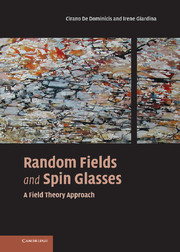Book contents
- Frontmatter
- Contents
- Preface
- List of abbreviations
- 1 A brief introduction
- 2 The Random Field Ising Model
- 3 The dynamical approach
- 4 The p = 2 spherical model
- 5 Mean field spin glasses: one-step RSB
- 6 The Sherrington–Kirkpatrick Model
- 7 Mean field via TAP equations
- 8 Spin glass above D = 6
- 9 Propagators, mostly replicon
- 10 Ward–Takahashi Identities and Goldstone modes
- 11 Alternative approaches and conclusions
- Appendix A Renormalization at one loop: ϕ4 theory (pure Ising)
- Appendix B Renormalization at one loop: tr ϕ3 theory (spin glass)
- Index
8 - Spin glass above D = 6
Published online by Cambridge University Press: 21 October 2009
- Frontmatter
- Contents
- Preface
- List of abbreviations
- 1 A brief introduction
- 2 The Random Field Ising Model
- 3 The dynamical approach
- 4 The p = 2 spherical model
- 5 Mean field spin glasses: one-step RSB
- 6 The Sherrington–Kirkpatrick Model
- 7 Mean field via TAP equations
- 8 Spin glass above D = 6
- 9 Propagators, mostly replicon
- 10 Ward–Takahashi Identities and Goldstone modes
- 11 Alternative approaches and conclusions
- Appendix A Renormalization at one loop: ϕ4 theory (pure Ising)
- Appendix B Renormalization at one loop: tr ϕ3 theory (spin glass)
- Index
Summary
In the previous chapters we have analyzed in detail the SK model and its solution within the replica method and via mean field-like TAP equations. The physical scenario unveiled by the RSB solution is novel and intriguing, depicting a low temperature phase where ergodicity is broken in a multiplicity of pure states with a nontrivial structure. Yet, so far we have been dealing with a mean field model and one may wonder whether all these surprising results are just an artefact of the long range interaction. This question is indeed very much debated and different points of view exist with conflicting conclusions. In this book hereafter we shall embrace what seems a most natural approach for the finite dimensional model, developing a field theory that has as mean field limit the SK solution described in Chapter 6, and building up a perturbation expansion around it. This is justified if we assume that the physics of the SK model remains qualitatively relevant for a finite dimensional system. Vice versa, we may say that, if we are able to build a well defined field theory and control its perturbation expansion, this is a strong indication of the physical relevance of its content.
Even if our program is conceptually standard routine in field theory, from a practical point of view it is far from simple, given the complex nature of the order parameter. As we shall see, even the analysis of Gaussian fluctuations becomes cumbersome.
- Type
- Chapter
- Information
- Random Fields and Spin GlassesA Field Theory Approach, pp. 141 - 158Publisher: Cambridge University PressPrint publication year: 2006

